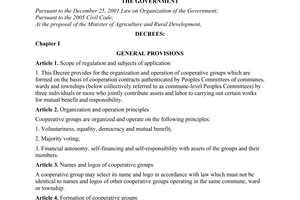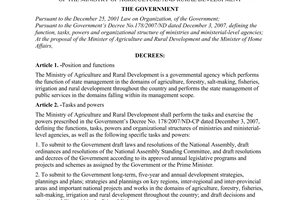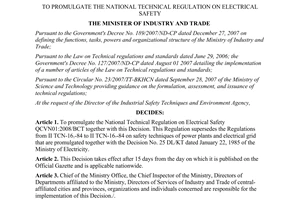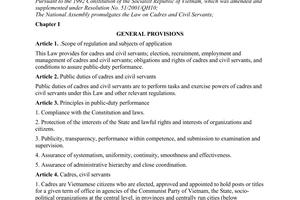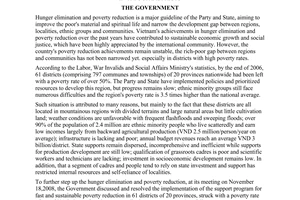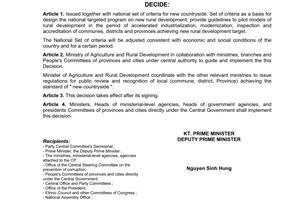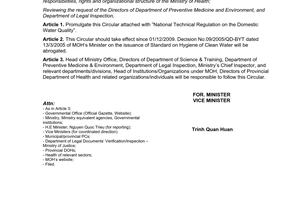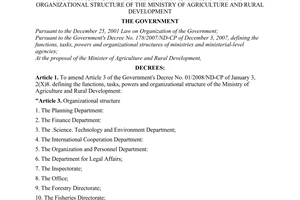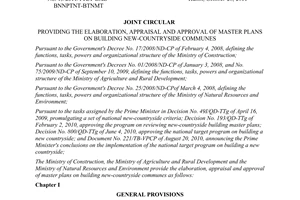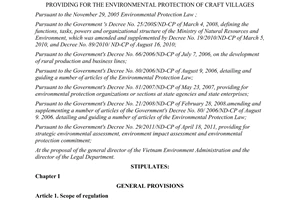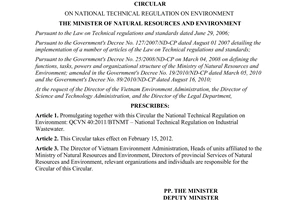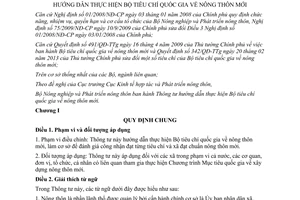Nội dung toàn văn Circular 41/2013/TT-BNNPTNT instructions on application of national set of criteria for new rural development
|
THE MINISTRY OF
AGRICULTURE AND RURAL DEVELOPMENT |
THE SOCIALIST
REPUBLIC OF VIETNAM |
|
Hanoi, October 04, 2013 |
CIRCULAR
INSTRUCTIONS ON APPLICATION OF NATIONAL SET OF CRITERIA FOR NEW RURAL DEVELOPMENT
Pursuant to the Government's Decree No. 01/2008/ND-CP dated January 03, 2008, defining the functions, tasks, powers and organizational structure of the Ministry of Agriculture and Rural development, the Government's Decree No. 75/2009/ND-CP dated September 10th 2009, amending Article 3 of the Decree No. 01/2008/ND-CP dated January 03, 2008;
Pursuant to the Prime Minister’s Decision No. 491/QD-TTg dated April 16, 2009 on promulgation of the set of national criteria on new rural development and the Prime Minister’s Decision No. 342/QD-TTg dated February 20, 2013 amending a number of articles of the national set of criteria for new rural development;
At the agreement among relevant ministries, sectors;
At the request of general director of Department of Cooperatives and Rural Development,
The Ministry of Agriculture and Rural Development has promulgated the Circular providing instructions on the application of the national set of criteria for new rural development.
Chapter I
GENERAL PROVISIONS
Article 1. Scope and regulated entities
1. Governing scope: This Circular shall serve as foundations for assessment and recognition of new rural standards of communes.
2. Regulated entities: This Circular applies to communes across the country, agencies, units, organizations and individuals engaging in the implementation of national target program for new rural development.
Article 2. Interpretation of terms
In this Circular, some terms are construed as follows:
1. Rural areas refer to the territory governed by People’s Committees of communes.
2. Village is the common name of small villages and hamlets and an autonomous organization of the residential community sharing a residential area in a commune.
3. Extremely disadvantaged communes:
a) Communes as stipulated in Program 135 (2012 – 2015) (abbreviated as ‘Program 135’); cape and island communes and other communes entitled to the investment mechanism under Program 135 according to the Government’s regulations;
b) Communes of poor districts as stipulated in the Government's Resolution No. 30a/2008/NQ-CP dated December 27, 2008 and communes of districts of high rate of poverty entitled to the infrastructure investment mechanism under the Resolution No. 30a/2008/NQ-CP.
Chapter II
METHOD FOR DETERMINATION OF SATISFIED CRITERIA
Article 3. Criteria of planning and planning implementation
To satisfy the criteria, a commune shall meet following requirements:
1. Obtain a new rural development master plan formulated according to Joint Circular No. 13/2011/TTLT-BXD-BNNPTNT-BTN&MT: The Ministry of Construction, Ministry of Agriculture and Rural Development and Ministry of Natural Resources and Environment shall stipulate the formulation and appraisal of the new rural development master plan which is approved by competent authorities and widely spread to villages.
2. Make public the drawings of the master plan to residents; complete the planting of boundary markers for infrastructural constructions according to the approved master plan.
3. Issue regulations on planning management approved by competent authorities;
Article 4. Criteria of traffic
1. To satisfy the criteria, a commune shall meet following requirements:
a) 100% of the arterial commune roads, inter-commune roads shall be paved with cement concrete or asphalt;
b) Hardened village roads shall reach prescribed proportion;
c) 100% of the hamlet, alley roads shall be hardened (no muddiness caused in rainy seasons);
d) Hardened in-field roads shall meet prescribed proportion.
2. Interpretation of terms
a) Hardened roads refer to the roads that are paved with asphalt, cement concrete, bricks, sawn stones or aggregates compacted with crushed stone, refuse stone, broken bricks.
b) Types of rural roads:
- Arterial commune roads refer to the roads connecting the commune’s administrative center and centers of the villages;
- Village roads refer to the roads connecting the village' center and residential quarters in the village;
- Hamlet, alley roads refer to the roads connecting households in residential quarters together;
- In-field roads refer to the roads connecting residential areas and centralized production areas of villages, communes.
c) Scale of rural roads:
- Rural roads shall be constructed under the planning by the Ministry of Transport: Planning and design of rural roads shall be based on TCVN 4054:2005 and the supplementary decision No. 315/QD-BGTVT dated February 23, 2011;
- Construction of rural roads: The communes shall rely on their own resources to determine priority works and roadmaps of implementation as appropriate. If the resources are limited, the planting of road boundary markers according to the planning for smaller roads shall be carried out first;
- For roads currently in operation: Renovate and make the most of the areas of road sides for road expansion with regard to narrow roads that cannot be expanded as prescribed, create collision avoidance points along the routes and carry out the planning for construction of parking lots to meet demands of households having cars. If road surfaces meet 80% of the requirement and the conditions above, the criteria are considered as satisfactory.
Article 5. Criteria on irrigation
1. To satisfy the criteria, a commune shall meet following requirements:
a) Reach prescribed ratio of canal solidification (except areas where solidification is inapplicable);
b) Maintain an irrigation that basically meets requirements of production and welfare.
2. Interpretation of terms
a) Solidification means reinforcement of canals using materials (stone, bricks, concrete, composite) to ensure stable and sustainable operation of canals. If irrigation is carried out through fixed piping, it is also called solidification.
- The ratio of solidified canals is the percentage between the total number of kilometers of canals which have been solidified and the total number of kilometers of canals that need to be solidified as prescribed.
- For communes in Mekong River Delta Region or areas where only solidification of sluices is required, the rate of solidification of sluices shall be applicable. Communes without canals, sluices that require solidification shall be considered as satisfactory.
b) An irrigation system that basically meets requirements of production and welfare shall meet following requirements:
- Provide an irrigation work which is constructed according to the approved planning and design, regularly maintained and repaired to exploit more than 80% of its design capacity;
- Serve production, cultivation and aquaculture; basically meet demands for water for domestic activities, production of livestock and poultry and non-agricultural production activities in the administrative division;
- Maintain an organization (cooperatives or artels) for management, operation and protection of the work, ensuring efficient and sustainable operation of canals, sewers, embankments, dams.
Article 6. Criteria on rural electricity
1. To satisfy traffic criteria, a commune shall meet two requirements as follows:
a) Maintain a system to ensure technical requirements of electricity sector;
b) Achieve prescribed ratio of households using electricity frequently and safely.
2. Interpretation of terms
a) Rural electricity system includes: Electrical substations, distribution stations, middle and low-voltage transmission lines, electrical meters serving production and rural life;
b) Electricity system ensuring technical requirements of electricity sector means meeting Technical regulations on rural electricity (Technical Regulation – Rural Electricity 2006) enclosed with the Decision No. 44/2006/QD-BCN dated December 08, 2006 issued by the Ministry of Industry (Now ‘the Ministry of Industry and Trade’) including determination of loads, distribution grids, distribution substations, low-voltage transmission lines, safety distance and protection corridors, voltage quality. Electricity system management agencies in the administrative division of the commune shall be responsible for determining level of satisfaction of the criteria.
c) Rural power sources include: Power sources connected to the national grid, or to electrical grids other than the national grid. For administrative divisions where access to the national grid is not available, depending on particular conditions in localities, stationary electrical generation vehicles such as small hydropower plants, wind, solar and diesel power plants, or power plants running on the combination of those sources shall be considered for use.
d) Regular use of electricity means ensuring daily availability of electricity.
dd) Assurance of electricity safety means meeting National technical regulation on electricity safety (QCVN 01: 2008/BCT) enclosed with the Minister of Industry and Trade’s Decision No. 12/2008/QD-BCT dated June 17, 2008.
Article 7. Criteria on schools
1. To satisfy the criteria, a commune shall reach prescribed ratio of schools equipped with facilities reaching national standards.
2. Interpretation of terms
a) Schools include: Pre-schools, kindergartens, primary schools, secondary schools.
b) Schools reaching national standards on facilities as stipulated by the Ministry of Education as follows:
- Pre-schools shall achieve national standards at level 1 according to the Regulation on recognition of national standards for pre-schools enclosed with the Minister of Education and Training’s Decision No. 36/2008/QD-BGDDT dated July 16, 2008.
- Primary schools reach national standards level 1 as stipulated in the Minister of Education and Training’s Circular No. 59/2012/TT-BGDDT dated December 28, 2012 on standards on assessment and recognition of national standards, minimum quality for primary schools.
- Secondary schools reach national standards as prescribed in the Minister of Education and Training's Circular No. 47/2012/TT-BGDDT dated December 07, 2012 promulgating the Regulation on recognition of national standards for lower, upper secondary schools and multi-level general schools.
c) Ratio of schools at all levels equipped with facilities reaching standards is the percentage between the number of schools meeting standards on facilities and the total number of schools.
Article 8. Criteria on education
1. To satisfy criteria, a commune shall meet two requirements as follows:
a) Achieve universalization of lower-secondary education;
b) Achieve lower secondary graduation ratio and trained labor ratio as prescribed.
2. Interpretation of terms
a) Achieving the universalization of lower secondary education is to achieve:
- From 90% (70% for extremely disadvantaged communes) and over in annual lower secondary graduation ratio;
- From 80% (70% for extremely disadvantaged communes) and over in lower secondary graduation ratio for students aged 15 - 18.
b) The ratio of students who continue to learn at upper secondary schools, continuation schools, vocational schools (in continuing education centers or vocational training schools) is the percentage between the number of students continuing schooling and the total number of students graduating from lower secondary schools.
c) Trained labor is the labor force that have undergone short-term or long-term training courses and received certificates of vocational training or degrees from professional secondary schools and over.
Article 9. Criteria on cultural facilities
To satisfy the criteria, a commune shall meet following requirements:
1. Maintain a cultural house and a commune-level sporting center reaching the standards as stipulated in the Minister of Culture, Sports and Tourism’s Circular No. 12/2010/TT-BVHTTDL dated December 22, 2010.
2. 100% of villages have a cultural house and sporting center meeting standards as stipulated in the Minister of Culture, Sports and Tourism’s Circular No. 06/2011/TT-BVHTTDL dated March 08, 2011.
Article 10. Criteria on culture
To satisfy the criteria, a commune shall maintain at least 70% of villages which have been recognized as the recipient of the title "Cultural Village" and have held such title for at least five consecutive years.
Article 11. Criteria on rural market
1. To satisfy the criteria, a commune shall meet following requirements:
a) Technical level: Maintain sufficient rural market constructions (market class 3) as stipulated in TCVN 9211:2012 enclosed with the Minister of Science and Technology’s Decision No. 3621/QD-BKHCN dated December 28, 2012 on public announcement of national standards.
b) Market management:
- Maintain a management organization;
- Establish market rules stipulated by the People’s committees of communes and published for management and handling of violations;
- Put into use control scales, measuring equipment for consumers to inspect quantities of goods by themselves;
- Goods and services traded at the market are not subject to prohibition as prescribed.
2. Regulated entities:
a) Communes with markets constructed in conformity with the planning for market networks approved by the People’s committees of districts;
b) For communes with markets outside the district’s planning, separate regulations (if any) of the People’s committees of districts shall apply.
Article 12. Criteria on post offices
1. To satisfy the criteria, a commune shall meet two requirements as follows:
a) Maintain at least one point of postal and telecommunications services meeting standards as prescribed in the Minister of Information and Communications’ Decision No. 463/QD-BTTTT dated March 22, 2012.
For communes with islands populated by at least 200 inhabitants, a point of public postal and telecommunications services shall be provided.
b) Ensure access to the Internet.
2. Interpretation of terms
a) The point of post and telecommunications services is the point that provides either or both of the services: Public postal and telecommunications services managed by post and telecommunications enterprises based in the administrative division.
b) Postal services refer to the services of receiving, transporting and delivering postal packages from the sender’s address to the recipient’s through postal networks except electronic modes.
c) Telecommunications refer to activities of sending, transmitting, receiving and processing symbols, signals, figures, text, images, sounds or other form of information through cables, radio wave, optical and electromagnetic means.
d) Telecommunications services refer to the services of sending, transmitting, receiving and processing information between two or more service users including basic services and value-added services.
Article 13. Criteria on housing
1. To satisfy the criteria, a commune shall meet following requirements:
a) Ensure no more households living in temporary or leaky houses;
b) Reach a minimum proportion of households owning houses meeting standards as stipulated by the Ministry of Construction.
2. Interpretation of terms
a) Temporary and leaky houses are types of houses made of makeshift, flammable materials with service life less than five years or failing to ensure have hard foundations, hard frame, and hard roof, short of living space, kitchens, toilets as prescribed, not ensuring safety for occupants.
b) To meet the Ministry of Construction’s standards, rural houses shall meet following requirements:
- The house has a hard foundation, hard frame and hard roof and at least 14 m2 of living space per person;
- Ensure service life of housing works is at least 20 years;
- Auxiliary works (kitchens, toilets, livestock facilities …) are arranged in such a way to ensure hygiene and convenience for activities.
- Housing architecture and designs are in conformity with customs, practices, habits, lifestyles of individual peoples, regions.
Article 14. Criteria on incomes
1. To satisfy the criteria, a commune shall ensure annual average income reaches the minimum rate as prescribed.
2. Annual average income calculation method:
a) Annual average income is calculated by dividing the amount of money and values in kind earned by a household minus the production cost in a year by the total number of members in the household.
b) Household income includes:
- Income from agricultural, forestry, fishery and salt production after deduction of production cost, taxes and other costs (if any);
- Income from non-agricultural, non-forestry, and non-fishery production after deduction of production cost, taxes and other costs (if any);
- Income from salaries and wages;
- Income from salaries and wages earned from non-agricultural activities inside and outside the administrative division;
- Other incomes: Gifts, saving interests …
c) Earnings not recorded in incomes: Social benefits, grants for electricity bills, savings, collection of debts, sale of assets, loans, advances …
d) Survey on annual average income shall be conducted by the commune itself and the calculation thereof shall be carried out under the instruction of General Statistics Office. Statistical Branch Offices of districts shall be responsible for cooperating with the commune in the survey, conducting appraisal and making the submission to the People’s committees of districts for recognition.
Article 15. Criteria on poor households
1. To satisfy the criteria, a commune shall ensure that the proportion of poor households is below the minimum level as prescribed.
2. Rural poor households are the households with per capital income within the poverty threshold as stipulated by the Prime Minister which are applicable in each stage.
Article 16. Criteria on ratio of regularly employed labor force
1. To satisfy this criteria, a commune shall ensure that the proportion of regularly employed labor force is 90% and over.
2. Regularly employed labor force is the working-age people who register permanent residence in the commune and work for at least 20 days per month in a year both inside and outside the administrative division.
Proportion of regularly employed labor force is the percentage between the number of regularly employed people and the total number of working-age population in the commune.
Article 17. Criteria on manner of production organization
1. To satisfy the criteria, a commune shall have at least one cooperative or artel which are registered and operate effectively according to laws and sign a business cooperation contract with enterprises.
2. Interpretation of terms
a) A cooperative that operates effectively shall meet following requirements:
- Be established and operate in accordance with the Law on Cooperatives 2012;
- Be capable of providing at least one type of basic, essential service in conformity with characteristics of each area serving members of the cooperative and residents in the administrative division.
- Gain business profits continuously for three consecutive years (or at least two years for newly-established cooperatives).
b) An artel that operates effectively shall meet following requirements:
- Be established and operate in accordance with the Prime Minister’s Decision No. 151/2007/ND-CP dated October 10, 2007 and the Ministry of Planning and Investment’s Circular No. 04/2008/TT-BKH dated July 09, 2008.
- Gain business profits continuously for three consecutive years (or at least two years for newly-established artels).
c) Long-term cooperate between farm households (or artels, cooperatives) and enterprises, scientific organizations or scientists is the contract signed between the parties for production, processing and consumption of agricultural products for a period of at least three years.
Article 18. Criteria on health
1. To satisfy the criteria, a commune shall meet following requirements:
a) The commune's medical facilities reach national standards;
b) Proportion of participants in medical insurance is at least 70%.
2. Medical facilities that reach national standards shall meet regulations of the Minister of Health's Decision No. 3447/QD-BYT dated September 22, 2011.
3. The proportion of participants in medical insurance is the percentage between the number of holders of health insurance cards that remain in force and total population in the commune.
Medical insurance includes: Insurance supported by the state, compulsory or voluntary.
Article 19. Criteria on environment
1. To satisfy the criteria, a commune shall meet following requirements:
a) The proportion of households using clean and hygienic water as prescribed meets the rate as prescribed;
b) 90% of production and trade facilities in the administrative division meets environmental standards. (Remaining 10% is in the process of improving);
c) Village roads, hamlets, alleys and landscape of households are green, clean and beautiful without environmental degradation activities;
d) Graveyards are arranged and constructed within the approved planning;
dd) Waste matters, wastewater is collected and treated as prescribed.
2. Interpretation of terms
a) The proportion of households using clean and hygienic water as prescribed;
- Clean water of national standards is the water that meet criteria as prescribed in National technical regulation (QCVN:02:2009/BYT) on quality of tap water issued by the Minister of Health in the Circular No. 05/2009/TT – BYT dated June 17, 2009.
- Hygienic water is the water that is accessed directly or after filtration and meet quality requirements (no color, odor, strange taste, components harmful to human health; being drinkable after boiling);
- Proportion of households using hygienic water and clean water of national standards by region shall be stipulated as follows:
+ Midlands of Northern highlands and Central Highlands: Proportion of households having access to hygienic water is 80% of which 45% have access to clean water of national standards;
+ Red River Delta, the Southeast and Mekong River Delta: Proportion of households having access to hygienic water is 90% of which 50% have access to clean water of national standards;
+ The north central coast and the south central coast: Proportion of households having access to hygienic water is 85% of which 50% have access to clean water of national standards;
b) Production and trade facilities reaching environmental standards shall meet provisions set out in the Minister of Natural Resources and Environment’s Circular No. 46/2011/TT-BTNMT dated, Circular No. 47/2011/TT-BTNMT dated December 28, 2011 while performing activities of production and processing that generate wastewater, solid waste, odor, dust, exhaust, noise ...
Hygienic livestock farms are the farms that meet following requirements: Be separated from housing; waste generated from livestock production (manure, urine) shall be properly treated.
c) Village roads, hamlets, alleys and landscape of households that meet the criteria on greenness, cleanness and beauty without environmental degradation activities are to meet following requirements:
- Village roads, hamlets and alleys are green, clean and beautiful;
- Proportion of households performing renovation of gardens and fences is more than 90%; no muddiness is caused at hamlet, alley gates.
- No production and trade facilities (livestock production, food processing, handicraft production, scrap trading …) cause environment pollution.
d) Graveyards that are arranged and constructed within the approved planning are to meet following requirements:
- Each village or commune has its own long-term land planning for graveyards in conformity with local practices (except places where funeral practices do not require graveyards);
- Regulation on graveyard management is made available.
- Funeral practices are compliant with beliefs, customs, cultural traditions and modern civilization lifestyles.
dd) Waste matters, wastewater that is collected and treated as prescribed are to meet following requirements:
- Toilets, bathrooms meet prescribed standards; drainage system (wastewater, domestic waste) ensures proper hygiene and no pollution to the air and surrounding water sources;
- Each centralized residential quarter of the village, commune has its own ventilated and hygienic drainage system;
- Each village, commune has its own service team which performs collection and treatment of waste at a centralized landfill.
Article 20. Criteria on strong socio-political organization system
1. To satisfy the criteria, a commune shall meet following requirements:
a) 100% of public officials and civil servants in the commune meet standards as prescribed in Ministry of Home Affairs’ Circular No. 06/2012/TT-BNV dated October 30, 2012;
b) Maintain sufficient organizations in the grassroots-level political system as prescribed;
c) The commune’s Party Committee meets the standard “spotless and strong” as stipulated in the Instruction No. 07-HD/BTCTW dated October 11, 2011 issued by the Commission for Mass Organization;
d) The commune’s socio-political unions are recognized to have achieved the title “progressive organizations”.
2. Interpretation of terms
a) Socio-political organization system includes: Party organizations, governments and socio-political unions: Fatherland fronts, Communist Youth Union of Ho Chi Minh City, Women Associations, Veterans Associations.
b) Public officials, civil servants include titles, positions as prescribed in Article 61 of the Law on Cadres and Civil Servants 2008.
To meet standards, public officials and civil servants shall meet following requirements:
- Academic standards: Graduate from upper secondary schools (in case of lowland and urban regions), from lower secondary schools (in case of mountainous and island regions);
- Professional level: Graduate from professional secondary schools with regard to training areas in conformity with the tasks performed by civil servants;
- Computer level: Obtain at least Level A in computer science;
- Work for a long time in the areas of ethnic minorities, have a good command of one ethic minority language;
- Accomplish certificates of state management and political reasoning as prescribed after being recruited;
c) Titles: Title “Spotless and strong grassroots party organizations” shall be annually awarded by Executive board of the Party Committee.
d) Title “Spotless and strong government” shall be annually awarded by the People’s committees of districts.
dd) Title “Progressive unions” shall be annually awarded by district-level union organizations .
Article 21. Criteria on social security and order
To satisfy the criteria, a commune shall meet following requirements:
1. Ensure no organizations or/and individuals carry out activities undermining the Communist Party, Government and the economy; ensure no illegal preaching be conducted to large crowds for a long time;
2. Ensure no existence of disorderly social events or gatherings and debaucheries in the administrative division;
3. Over 70% of the villages are recognized to having met standards on security and order;
4. Annually, the commune’s police authorities achieve at least the title "progressive unit".
Chapter III
IMPLEMENTATION
Article 22. Responsibility of People’s Committees of central-affiliated provinces, cities
1. Realize contents of the national set of criteria on new rural development in conformity with specific conditions of localities based on the Central Government’s regulations.
2. Stipulate standards of new rural development for individual areas in the administrative division in accordance with actual conditions based on the Central Government’s regulations.
3. Assign professional regulatory bodies to preside over and cooperate with relevant agencies in performing assessment of individual criteria within management in the administrative division based on written instructions from ministries or central agencies.
Article 23. Effect
1. This Circular supersedes the Ministry of Agriculture and Rural Development’s Circular No. 54/2009/TT-BNNPTNT dated August 21, 2009 providing instructions on implementation of national set of criteria on new rural development, effective since November 20, 2013.
2. Difficulties that arise during the implementation of this Circular shall be reported to the Ministry of Agriculture and Rural Development for supplements and amendments. In special cases, the People’s Committees of provinces shall make the report to the Central Steering Committee on national target program for new rural development for decision./.
|
|
MINISTER |
------------------------------------------------------------------------------------------------------
This translation is made by LawSoft and
for reference purposes only. Its copyright is owned by LawSoft
and protected under Clause 2, Article 14 of the Law on Intellectual Property.Your comments are always welcomed
